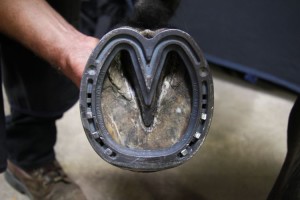This topic was sent in by one of our readers – thanks for the idea! It’s always great to get feedback, so please feel free to fill out the survey form and let me know what other topics you’re interested in.
I’m going to start with a discussion on shoeing for Saddlebreds. In future articles, I’ll talk about Morgan and Arabian/Half Arabian shoeing, so check back in if those are your breeds of interest.
Before we dive into the shoeing regulations for each division, I want to take a second to talk about good shoeing in general. It’s very important that your horse be shod in a balanced, healthy manner. To me, this means a reasonable length of hoof, a reasonable amount of pad (if desired/allowed), and a reasonable size shoe. What does “reasonable” mean? I define it as the minimum amount of shoeing that is needed to help the horse do its job to the best of its abilities, without causing any harm or damage to the horse. Adding more length or weight will usually not give the desired results (i.e. more motion) but instead, create a clunky moving horse. Judges want to see a graceful, light moving horse.
In fact, the USEF rule book states that “the standard of excellence of the American Saddlebred is beauty, symmetry and balance. Balance features coordinated motion, with straight true folding action of the front legs with flexing hocks carried close together, producing a clean, rhythmic and fluid way of going. In addition, the American Saddlebred possesses animation, brilliance and extreme grace of movement.” So keep that in mind when you’re making shoeing decisions – keep the horse’s movement rhythmic, fluid, and straight, and don’t take away their animation, brilliance or grace. The rest is up to nature. You can’t nail on motion, so there’s no point in overdoing it. Also, it’s worth mentioning that horses can be shown barefoot in any division.
You can find the full rules for Saddlebreds here. It’s always best to review the rules yourself if you have any questions.
Country Pleasure
This section covers all divisions of Country Pleasure – Saddle Seat, Driving, Hunt Seat, and Western, as well as Country Park Pleasure (I have never seen this class offered but you never know!). In general, a Country Pleasure horse can be shod however you want, as long as it doesn’t have “bands, bars, pads of any kind, wedges, lead, springs, any attachment that extends below the bottom of the shoe, and any foreign substance not specified as permissible.” There are no restrictions on length of hoof or weight of shoe.

The rules also say that the sole of the foot and the entire frog must be visible, so certain types of remedial shoeing such as heart bar shoes would violate this rule. You also cannot use rim pads. I get that question a lot and the answer is no. No pads of any kind.
In practice, I think a Saddle Seat or Driving horse should be shod for maximum height of stride, a Hunt horse should be shod for maximum reach and openness of the stride (particularly at the walk and canter as those gaits are the most important for true Hunters), and a Western horse shod for maximum comfort of the rider. Of course, you want to make sure the horse is also shod to prevent any kind of interfering or forging, especially if they are turned out.
All Other Divisions
In all other Saddlebred divisions, there are no shoeing regulations. However, the rules for each division give some guidelines around how a horse should move.
- Five Gaited Performance: “energy should be directed toward speed in an animated form”
- Three Gaited Performance: “gaits are collected and energy directed toward animation and precision”
- Fine Harness: “energy should be directed toward animation rather than speed”
- Park: “animated and graceful in all gaits”
- All Pleasure Divisions: “easy, ground-covering action is desired”
- Show Pleasure: “has less animation than the Three-Gaited, Five-Gaited and Fine Harness Performance horse but should be alert and responsive. High, natural, free-moving action is desirable. Laboring action due to excessive weight of shoes or length of foot is penalized”
- Park Pleasure (same rules as Show Pleasure): “animated and graceful in all gaits”
Hoof Care
A discussion of shoeing wouldn’t be complete without talking about hoof care. I only use two things on hooves: Keratex Hoof Hardener and a good diet. OK, ocassionally I might swipe on some Rainmaker. But that’s it. There are hundreds (or maybe even thousands?) of hoof products out there, and I’m sure you have your favorites. But if you’re having trouble keeping shoes on your horse, the hooves crack and split, or you find yourself needing to use bands because the hoof wall is shelly, you might want to try Keratex Hoof Hardener. I’ve used it with great luck on several horses with shelly walls, and my farrier was able to tell a difference in hoof quality after one reset.
If your horse has bad feet, you might also want to look at what you’re feeding (or not feeding). Biotin, methionine, zinc, copper, calcium, vitamins A, B, D and E, and sufficient protein and Omega 3s and 6s will help. Omegas should be fed in a ratio between 4:1 to 6:1 of Omega 3:Omega 6. Flaxseed is a great Omega supplement with the correct ratios. Don’t overfeed Omega 6 (corn and canola oils are high in Omega 6) because it promotes inflammation. Also, make sure your horse isn’t getting too much selenium. That has become a popular additive to many grains and supplements nowadays, and too much can cause brittle hooves and dry hair. Ideally, you want your horse to be getting around 3-4mg/day.
Your best bet if you have any questions about shoeing is to contact USEF or the governing body for your show. There are some local circuits with different rules (for example, one of the state associations I show under allows both Country Pleasure and Show Pleasure horses (with pads) in the Western division), so be sure to check with them before you arrive!
- Fixing the One-Sided Horse - March 28, 2016
- Running Martingales, Draw Reins and German Martingales – A Physics Lesson - November 23, 2015
- What to Do in the Off Season - October 14, 2015

so what would I ask my farrier to do for “maximum height of stride?” I am new to saddle seat, having been given a NSH “old campaigner”, would like to help him show himself to the best of his ability! [but still want him to be able to be turned out in the pasture year round] :} [he previously was a champion country pleasure horse]
Your best bet is to ask your farrier to watch the horse work and he can make recommendations. It’s often a process of trial and error until you find just the right combination of things to maximize your horse’s potential.
ok, I will do that! thank you for the reply. :}}